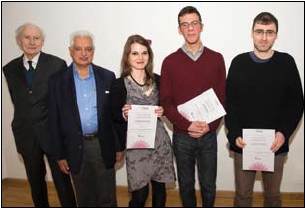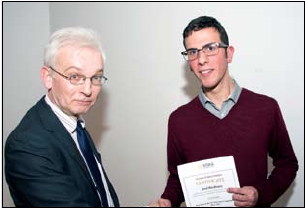
Centre of Jaina Studies Newsletter: SOAS - University of London
The SOAS Centre for Jaina Studies hosted the 15th Jaina Studies Workshop on 22 March 2013 The theme was Jaina logic. On the evening prior to the workshop, Piotr Balcerowicz (University of Warsaw) delivered the 13th Annual Jaina Lecture: Jaina Logic and Epistemology: Is This How It All Began?
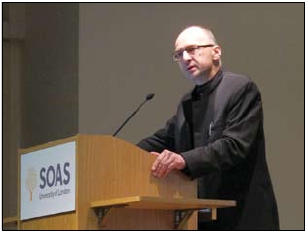 |
| Piotr Balcerowicz (University of Warsaw) |
Balcerowicz discussed the beginnings of Jainism and the origin of anekāntavāda. With this aim, he examined the relation between Jainism and the movement of the Ājīvikas, concluding that Jainism borrowed important concepts from this rival sect. Balcerowicz substantiated his claim by arguing that Mahāvīra was the disciple of the older Gośāla, from whom Mahāvīra adopted practices that are now associated with Jaina mendicancy. Other points of overlap between the Jainas and the Ājīvikas can be found in their systems of leśyās and abhijātis (i.e. the classifcation of souls and people), the structure of both canons, and their mutual belief in 24 Tīrthaṅkaras. Apart from these Ājīvika influences that played a role in the early development of Jainism, Ājīvikism seems to be the source of important philosophical concepts that came to play a vital role in later Jaina philosophy. Whereas the early Jaina texts only mention opposite terms (P and ¬P), the Ājīvikas acknowledge a third possibility (P, ¬P, P & ¬P). This threefold pattern can be recognised as the basis of syādvāda. Further, Balcerowicz showed that several concepts that are diffcult to explain within the general Jaina framework, such as abhavya souls, which by nature are not capable of reaching mokṣa, ft nicely in the deterministic perspective of the Ājīvikas. Although Balcerowicz acknowledged that some of his arguments require further research, he concluded that they cumulatively support the central thesis that Jainism is in many aspects indebted to the Ājīvikas.
The next day, Johannes Bronkhorst (University of Lausanne) opened the workshop with a closely related topic, namely the connection between anekāntavāda and Ājīvikism. He started his lecture with a discussion of the Jaina solution to the paradox of causality. According to the Jainas, this paradox can be solved by looking at it from the perspectives of shape, material, time etc. In this way, a pot can exist from the perspective of material without existing from the perspective of form. However, the Māṭharavṛtti mentions that the ‘jīvakāḥ’ (an epithet for the Ājīvikas) solve this problem by stating that an effect is both ‘existing and nonexistent’. This is remarkable for two reasons. First, it shows that the Jainas and Ājīvikas shared the anekāntavāda doctrine. Second, since the paradox of causality enters the philosophical arena centuries after Mahāvīra, it follows that Jainism and Ājīvikism remained in contact with each other for at least half a millennium since their beginning. Although Bronkhorst did not make the bold claim that anekāntavāda was ultimately derived from the Ājīvikas, he concluded that there was a mutual influence between the Jainas and the Ājīvikas.
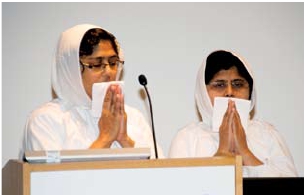 |
| Samaṇī Pratibhāprajñā and Samaṇī Himat Prajñā |
Masahiro Ueda (Kyoto University) examined the concept of nikṣepa in the works of Akalaṅka. As a subset of anuyogadvāra, nikṣepa is one of the methods to investigate the words in sacred scriptures. Although previous work has been done on the clarifcation of nikṣepa in the age of Āgamas, the role and meaning of nikṣepa in the age of logic have not been studied so far. In this period, nikṣepa was regarded as a way of perception, similar to the concepts pramāṇa and naya. As a key player in the completion of Jaina logic, Akalaṅka paid special attention to nikṣepa. Ueda showed that Akalaṅka in his Tattvārthavārttika follows the defnition and fourfold division that can be found in Pūjyapāda’s Sarvārthasiddhi. Ueda’s lecture concluded with a survey of Akalaṅka’s Laghīyastraya and Siddhiviniścaya, whereby he showed that both the description of nikṣepaand the relation of this concept with pramāṇa and nayaunderwent substantial change, which can be partly seen as an original contribution of Akalaṅka himself. Peter Flügel (SOAS) questioned the relation between Jaina logic and the concept of time. He proposed a phenomenological approach to time to reconstruct the evolution of Jaina perspectivist logic. Earlier research on the Jaina notion of time gives the impression that this concept was not well developed; there is a multiplicity of views, which are not well integrated into the broader framework. However, Flügel argued that time is actually a crucial notion for Jaina philosophy and soteriology since causation, omniscience, and anekāntavāda cannot be fully explained without a concept of time. Moreover, without a systematisation of the notion of time, classical Jainism could not have been established as a recognised philosophical school. Flügel showed that the Jaina realist solution to the question of change, whereby time is considered as a substance without mass, only leads to circularity. Hence, he argued that a phenomenological approach, in which time is considered as an object of time-consciousness, would improve the consistency of Jaina logic.
Dharmchand Jain (Jai Narain Vyas University) gave a broad overview of Jaina epistemology. He sketched the development of Jaina epistemological doctrines, after which he elaborated on specifc Jaina contributions to Indian epistemology. One of these contributions is the Jaina defnition of pramāṇa, whereby pramāṇais considered as illuminating both itself and its object. Further, from Umāsvāti onwards, the Jainas developed a unique categorisation of pramāṇas. In this system, Jaina philosophers established recollection (smṛti), recognition (pratyabhijñāna) and inductive reasoning (tarka) as independent pramāṇas. Another contribution that Jain highlighted is the detailed elaboration of the concept of the probans (hetu). He concluded that, given the mentioned contributions of Jaina thought to Indian epistemology, the Jaina literature is of crucial importance for our understanding of Indian epistemology in general.
Olle Qvarnström (Lund University) presented a debate between Jaina and Sāṃkhya philosophers on the relation between the self (puruṣa/ātman) and knowledge. Qvarnström discussed Haribhadrasūri’s Śāstravārtāsamuccaya and Yogabindu. Although the Jaina philosophers accepted the existence of the self, as did the Sāṃkhya philosophers, they did not accept that the self was a non-active principle. In view of this controversy, Haribhadra discusses the Sāṃkhya idea that the self only knows an object after the intellect (buddhi has ascertained it. This is explained by saying that the self is reflected in the intellect, whereby the intellect becomes transformed, as a result of which objects can be known. Haribhadra refutes this idea by pointing out that a nonmaterial self cannot be reflected in a material intellect. After a clarifcation of the content of this discussion, Qvarnström defended that Haribhadra’s texts shed light on an aspect of Sāṃkhya epistemology that hitherto has been unknown.
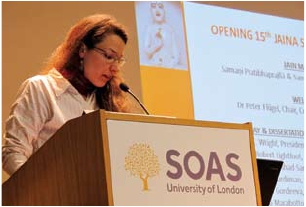 |
| Co-organiser Marie-Hélène Gorisse (Ghent University) |
Marie-Hélène Gorisse (Ghent University) focussed on the fve types of universal concomitance (vyāpti) that can be found in Māṇikyanandi’s Parīkṣāmukha. By contrasting this account with the Buddhist theory of inference in the tradition of Dharmakīrti, Gorisse illustrated the particularities of late Jaina theory of inference. A crucial difference between these two traditions is that the Buddhist philosophers hold that all cases of concomitance that allow for valid inferences can be reduced to identity of nature or causality. In contrast, Māṇikyanandi shows that these two relations are not suffcient to give a correct account of all justifed inferences. For example, the inference of a certain quality on the basis of its co-existence with a perceived quality, such as the taste and visual aspects of a mango, is neither based on identity nor on causality. Further, Māṇikyanandi defends that succession should be seen as a separate type of concomitance. Gorisse concluded that reducing the number of Māṇikyanandi’s types of invariable concomitance would obstruct valid ways to gain knowledge from inference.
Anne Clavel (University of Lyon) addressed the structure of the Jaina theory of viewpoints (nayavāda), based on Prabhācandra’s Nyāyakumudacandra and Abhayacandra’s Syādvādabhūṣaṇa. She showed an interesting pattern that underlies the distinction between ‘object-bound viewpoints’ (arthanaya) and ‘wordbound viewpoints’ (śabdanaya). Whereas arthanayas are statements that are concerned with ontological matters, śabdanayas focus on linguistic matters. Clavel demonstrated that three parallels can be drawn between the śabdanayas and arthanayas. These parallels show that the śabdanayas are not purely linguistic viewpoints but address ontological aspects as well. Although the śabdanayas are mainly applied to determine to which extent a word is appropriate for expressing a particular thing, they presuppose ontological distinctions. Therefore, Clavel concluded that the śabdanayas embody a critical approach towards both language and ontology.
Laurent Keiff (Lille University) addressed the same topic as Clavel, albeit from a different perspective. He claimed that there is a parallel between nayavāda and the current empirical approach in modern linguistics. To support this claim, he frst addressed how semantics and pragmatics are related. Whereas semantic information is encoded in what is uttered, pragmatic information is made relevant by an actor. However, semantics and pragmatics cannot be completely separated, since semantic information always needs a context. Keiff argued that at this point nayavāda shows similarities with modern thought. Next, he focussed on existential presuppositions and the way in which they are treated in dynamic semantics, in which the meaning of a sentence is regarded as its function in a context. He then showed how the nayas, as described in Prabhācandra’s Prameyakamalamārtaṇḍa, can be seen as guidelines to retrieve the meaning of a sentence in a specifc context.
Fujinaga Shin (Miyakonojō) examined the origin and logical value of the Jaina system of sevenfold predication (saptabhaṅgī). Fujinaga frst discussed early Digambara and Śvetāmbara sources in order to reconstruct the development of the standard form of saptabhaṅgī. He argued that Samantabhadra’s Āptamīmāṃsā and Kundakunda’s Pañcāstikāyasāra can be seen as the frst proponents of saptabhaṅgī in the Digambara tradition. In the tradition of the Śvetāmbaras, Haribhadra is the frst to mention saptabhaṅgī in its complete form. Nevertheless, the frst elements of saptabhaṅgī can already be found in the canonical tradition, such as in the Bhagavatīsūtra. The second part of Fujinaga’s lecture was dedicated to an evaluation of the logical value of saptabhaṅgī. Fujinaga showed that there is no logical reason to adhere to seven predications. He argued that Jaina philosophers developed the standard theory of saptabhaṅgī by imitating the seven varieties of nayas.
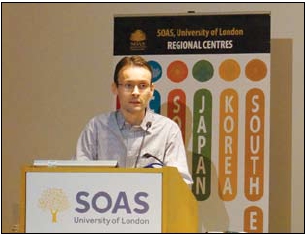 |
Fabien Schang (Université de Lorraine) |
Fabien Schang (Université de Lorraine) proposed a rational reconstruction of saptabhaṅgī from the perspective of modern logic. Focussing on formal semantics, Schang proposed a one-valued approach to saptabhaṅgī, whereby values are seen as ordered answers to initial questions about a sentence. In his approach, each element of saptabaṅgī is regarded as a statement about the semantic predicate of a given sentence. From this perspective, he reformulates ‘syād asty eva’ and ‘syān nāsti eva’ respectively as “the sentence α = ‘x is F’ is true from some standpoint” and “the sentence ~α = ‘x is not F’ is true from some standpoint.” After discussing the third semantic predicate (avaktavyam), Schang argued that anekāntavāda embodies a logic of ‘light inconsistency’ in which a sentence can be asserted and denied from different standpoints. He concluded his lecture with a comparison between saptabhaṅgī and catuṣkoṭi, stressing the soteriological purpose of both systems.
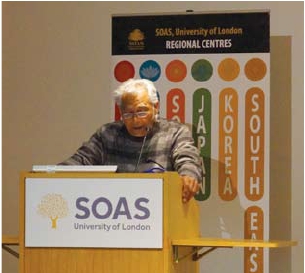 |
Jayandra Soni |
Jayandra Soni (Innsbruck) commented on K. K. Dixit’s Jaina Ontology. Soni began with a discussion of the general assumptions that underlay Dixit’s discussion of the age of logic. Dixit divides the logical developments of Jaina philosophy from the 4th to the 17th centuries in three periods and links these periods with specifc philosophical questions. However, this practical scheme led Dixit to important omissions and controversial opinions. Soni elaborated on a ‘mistake’ of Prabhācandra that is mentioned by Dixit. Dixit claims that Prabhācandra in his Nyāyakumudacandra misread the text of Akalaṅka and replaced ‘smṛti’ in a certain passage with ‘matiḥ’. However, by pointing to Akalaṅka's particular classifcation of pramāṇas, Soni defended that the error that Dixit sees in Prabhācandra’s work has to be reassessed in the light of Akalaṅka’s own words.
Himal Trikha (University of Vienna) examined the relation between Jaina perspectivism and rational critique with reference to Vidyānandin’s Satyaśāsanaparīkṣā. Although Jaina philosophy is often associated with intellectual tolerance, this notion plays no role in Vidyānandin’s work. In contrast, he attacks opposing views with the same rigor as Buddhist or Nyāya debaters. However, although saptabaṅgī-statements are not explicitly mentioned, Trikha claimed that nayavādaand syādvāda are still relevant notions in Vidyānandin’s method. With the aid of visual diagrams, Trikha showed how epistemic pluralism can be combined with the falsifcation of dissonant epistemic alternatives. He argued that this is the method that can be found in Vidyānandin’s work. To illustrate how this works, Trikha summarised Vidyānandin’s examination of the relation of jīva and cognition. Of the four possible views regarding their (partial) difference and identity, Vidyānandin falsifes two views, after which the remaining epistemic events are established as part of a wider vision of the investigated object.
|
|
With a return to the frst theme of the conference, Andrew More (Yale University) concluded the conference with a lecture on the legitimation of Jaina lay life, thereby readdressing the rivalry between Jaina and non-Jaina mendicants. He focussed on several early Śvetāmbara passages from the Uvavāiya and the Sūyagaḍa. Although the oldest Jaina texts present the life of the mendicant as a necessary condition for the attainment of liberation and do not mention a lay community, there must always have been a relation between mendicants and supporting householders. In Sūyagaḍa 2.2 the lay community is positively described as a mixed category between dhamma and adhamma, whereby the lay mode of life is respectable insofar as it corresponds to the ideal. However, the non-Jaina mendicants are severely condemned in the same text. This seems to be inconsistent. More argued that the compiler of the Uvavāiya reworked the mentioned passage from the Sūyagaḍa in an attempt to solve this inconsistency.
In conclusion, the presented papers illustrated that Jaina logic is a multifaceted topic, which can be studied from many viewpoints. The conference showed the value of contemporary study of Jaina philosophy and demonstrated the relevance of an interdisciplinary approach in which philosophers and scholars from other disciplines play their part. 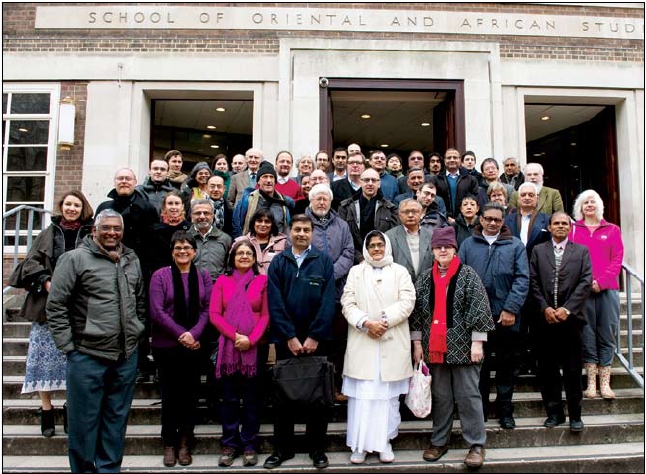
Lucas den Boer is a graduate student at the philosophy department of the University of Groningen (The Netherlands) and studies Sanskrit at Leiden University. He is working on a thesis on Guṇaratna’s Tarkarahasyadīpikā
